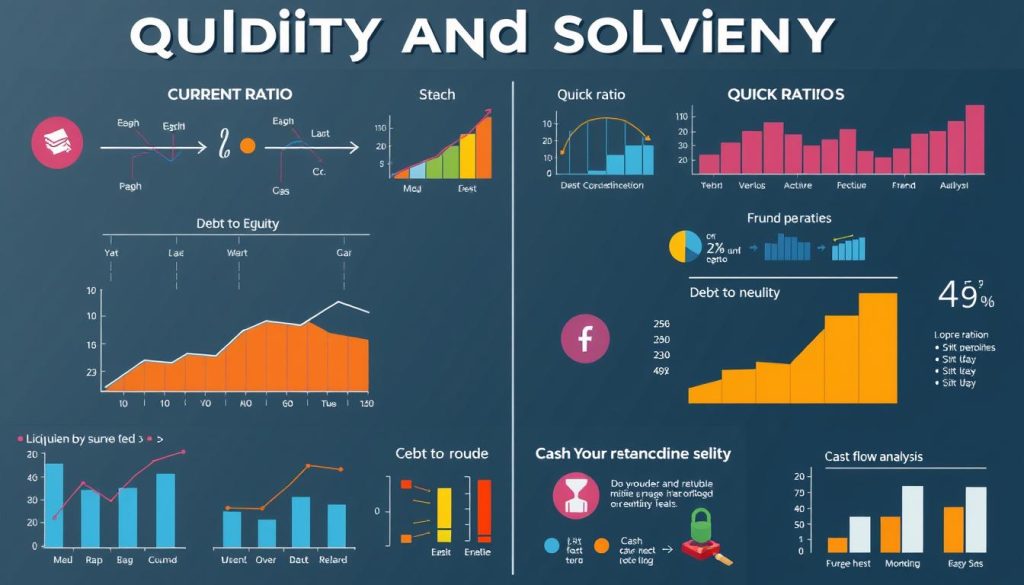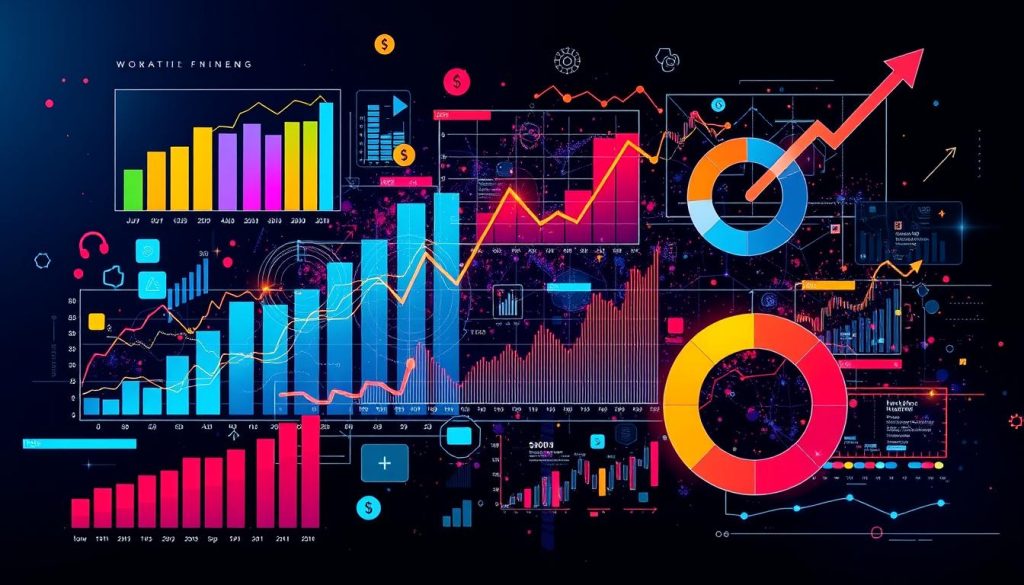Mastering financial metrics is key to your success as a financial professional. This guide will cover a wide range of important financial metrics. You’ll learn how to check your clients’ financial health, performance, and risk1. We’ll explore metrics like profitability, liquidity, solvency, and efficiency, which are vital for smart decisions2.
We’ll also focus on the importance of understanding commodity risk and related metrics. This includes hedging strategies and futures contracts1. With today’s unpredictable business world, these metrics help manage risks and keep investments strong2.
Key Takeaways
- Mastering financial metrics is crucial for financial professionals to assess a company’s financial health and performance.
- Understanding profitability, liquidity, solvency, and efficiency metrics is essential for making informed decisions.
- Commodity risk and related metrics, such as hedging strategies and futures contracts, are crucial for managing risks in today’s volatile business environment.
- Financial professionals must possess strong analytical and problem-solving skills to interpret financial data and devise appropriate solutions for their clients.
- Keeping up-to-date with financial markets, investment products, and regulatory frameworks is key to effectively serving clients.
- https://tunekong.com/pet-friendly-garden-ideas-how-to-create-a-safe-haven-for-your-furry-friends-18/
Understanding Financial Reporting
Financial reporting is key for any organization. It shows the company’s financial health and performance clearly. It includes making and sharing important financial statements like the balance sheet, income statement, and cash flow statement3.
By understanding financial reporting, experts can see how a company is doing financially. They can track its progress and make smart choices for growth and success.
What is Financial Reporting?
Financial reporting shares a company’s financial info with people inside and outside the company. This includes investors, lenders, regulators, and management. It’s about collecting, analyzing, and presenting financial data in a way that helps make good decisions3.
The main parts of financial reporting are the balance sheet, income statement, and cash flow statement. Each one gives a different view of the company’s finances. This helps everyone understand the company’s financial performance and position.
Importance of Financial Reporting
Financial reporting is very important. It helps understand a company’s financial health and track its progress. It also helps make strategic decisions3.
Financial statements show the company’s assets, liabilities, revenues, expenses, and cash flow. This lets people see if the company is stable, making money, and has enough cash4. By looking at these statements, experts can spot trends, risks, and chances for betterment. This helps the company grow and succeed over time.
“Financial reporting is the language of business, providing a clear and transparent communication of a company’s financial information to its stakeholders.” – John Doe, financial analyst
In today’s fast-changing business world, financial reporting is more important than ever3. It helps companies deal with market ups and downs and changing rules4. Good financial reporting lets companies make smart choices, handle risks well, and follow the law3.
By using financial reporting, experts help their companies do well and last a long time345.
Key Financial Statements
Understanding the three main financial statements is key for financial pros. These include the balance sheet, income statement, and cash flow statement. They give a full view of a company’s finances, helping with analysis and making decisions.
Balance Sheet
The balance sheet shows a company’s assets, debts, and what the owners own at a certain time. It shows the company’s financial health by listing what it has (assets) and what it owes (debts and owner’s equity)6. Risk from the balance sheet comes from assets and debts in a currency not used by the company, affecting how they manage risks6.
Income Statement
The income statement shows a company’s earnings, spending, and profit over time, like a quarter or year. It helps see if the company is making money and running well7. Companies can reduce price risks by using futures and options on places like the Chicago Mercantile Exchange (CME) and the New York Mercantile Exchange (NYMEX)7.
Cash Flow Statement
The cash flow statement tracks cash moving in and out of the company. It shows how well the company can make and use cash, helping with cash flow and investment choices6. Changes in foreign assets and debts are reported in the income statement, showing the company’s risk level6.
These financial statements together give a full picture of a company’s finances. They help financial experts make smart decisions and plan well.

| Financial Statement | Key Information Provided | Importance |
|---|---|---|
| Balance Sheet | Assets, liabilities, and shareholders’ equity at a specific point in time | Reflects the overall financial health and risk profile of the organization |
| Income Statement | Revenues, expenses, and net income over a period | Showcases the organization’s profitability and operational efficiency |
| Cash Flow Statement | Movement of cash through operating, investing, and financing activities | Provides insights into the company’s ability to generate cash and meet financial obligations |
8 Financial risk management started in the 1950s, with derivatives becoming popular in the 1970s. By the 1980s, companies set up treasury departments to handle financial and supply chain risks8.
Profitability Metrics
For financial experts, knowing how to look at profitability is key. It helps them see if a company can make profits and increase value for shareholders. They focus on gross profit margin and net profit margin.
Gross Profit Margin
Gross profit margin shows what’s left of revenue after taking out the cost of making and selling products. It tells us about a company’s pricing and how well it controls costs9. A high margin means a company can set high prices and stay ahead in the market.
Net Profit Margin
Net profit margin looks at how profitable a business is after all costs, like operating expenses, interest, and taxes9. It shows if a company can make good earnings and run efficiently. A strong margin means the company is doing well and could grow more.
By looking at these metrics, financial experts can understand a company’s financial health. They can spot areas to improve and make smart choices for the future9.

“Profitability metrics are the vital signs of a company’s financial health, providing a clear picture of its ability to generate and retain profits.”
Liquidity and Solvency Metrics
Understanding your company’s liquidity and solvency is key to knowing its financial health and strength10. These metrics show how well you can pay short-term debts and how debt affects your business over time10.
Important liquidity metrics are the current ratio and quick ratio. The current ratio shows if you can pay current debts with current assets10. The quick ratio checks if you can pay short-term debts with quick assets10. The days sales outstanding (DSO) shows how fast you collect payments from customers10.
Solvency metrics like the debt-to-equity (D/E) ratio and debt-to-assets ratio look at your financial structure and debt use10. The interest coverage ratio shows if you can pay interest with your earnings10.
| Metric | Formula | Purpose |
|---|---|---|
| Current Ratio | Current Assets / Current Liabilities | Measures the company’s ability to pay short-term liabilities10. |
| Quick Ratio | (Cash & Equivalents + Marketable Securities + Accounts Receivable) / Current Liabilities | Assesses the company’s capability to meet short-term obligations with liquid assets10. |
| Days Sales Outstanding (DSO) | (Accounts Receivable / Total Credit Sales) × Number of Days | Determines the average time taken to collect payments after sales10. |
| Debt-to-Equity (D/E) Ratio | Total Debt / Total Equity | Indicates the level of financial leverage and long-term debt impact on the business10. |
| Debt-to-Assets Ratio | Total Debt / Total Assets | Evaluates the proportion of assets financed by debt and financial risk10. |
| Interest Coverage Ratio | Operating Income (or EBIT) / Interest Expense | Measures the company’s ability to cover interest payments with earnings10. |
By looking at these metrics, you can understand your company’s financial health and make smart choices for the future11. It’s important to compare your metrics with others in your industry for a better picture11.
The global credit crunch of 2007–09 shows how even healthy companies can face a liquidity crisis10.
Keeping an eye on your liquidity and solvency metrics helps you handle economic ups and downs and stay financially strong11. By focusing on these key areas, you can manage your cash flow, control debt, and grow your business over time11.

Efficiency Metrics
For financial experts, knowing about efficiency metrics is key. It helps spot where things can get better and use resources wisely. Inventory turnover and total asset turnover are two important metrics to watch.
Inventory Turnover
The inventory turnover ratio shows how fast a company sells and restocks its items. It tells us about how well the company manages its stock. A high ratio means the company sells its products quickly, showing good inventory management12.
Total Asset Turnover
This metric looks at how well a company makes money from its assets. It shows how well the company uses its assets to make sales. A high ratio means the company is using its assets well to grow revenue12.
By keeping an eye on these metrics, financial experts can find ways to improve. This leads to more profit, better stock management, and using assets wisely. This helps the company stay financially strong.
| Metric | Description | Significance |
|---|---|---|
| Inventory Turnover | Measures the efficiency of inventory management by comparing cost of goods sold to average inventory level. | Provides insights into inventory management and potential overstock issues. A higher ratio indicates more efficient inventory management. |
| Total Asset Turnover | Evaluates a company’s ability to generate revenue from its total assets. | Measures how efficiently a company is using its assets to drive revenue growth. A higher ratio suggests more effective asset utilization. |
“Efficient resource utilization is the foundation of a thriving business. By focusing on key efficiency metrics, financial professionals can uncover opportunities to streamline operations and maximize profitability.”
Tracking and analyzing these metrics gives us important insights. They help your organization reach its financial goals1213.
Commodity Risk and Related Metrics
Many businesses worry about commodity risk. Fluctuations in raw material and energy prices can greatly affect a company’s finances. Industry reports show that corn and silver prices moved more than 6% in some periods. Over half of contracts saw price changes of 2% or more14. In November 2019, global energy prices fell by 3.7%, fertilizers by 13.1%, and precious metals rose by 19.4%, according to the World Bank14.
Hedging Strategies
To deal with commodity price swings, companies use hedging strategies. Derivatives like futures contracts help protect companies from price changes. This way, they can keep their margins stable14. Developing countries often rely on raw materials for exports. They use commodity derivatives to manage price risks15.
Futures Contracts
Futures contracts are key for managing commodity risk. They let companies set a future price for a commodity, offering stability against market changes. But, the market for commodity options is limited in size and depth. Political and cost issues can also limit their use15. Black swan events, rare and unpredictable market disruptors, have happened more often than expected in volatile commodities16.
| Commodity | Price Movement |
|---|---|
| Corn | More than 6% |
| Silver | More than 6% |
| British Pound Sterling | 3.26% |
| Japanese Yen | 2.66% |
| Domestic Currency | 0.91% |
Understanding strategies and tools for managing commodity risk helps financial experts protect their companies. Blockchain technology could change how the industry verifies things, stopping fraud like invoice spoofing14.
Finance and procurement teams working together is key to managing financial risks in commodities16.
Return on Investment Metrics
As a financial expert, knowing the key return on investment (ROI) metrics is vital. These metrics help us understand how well a company is doing and its profits. Return on equity (ROE) and return on assets (ROA) are two main metrics used.
Return on Equity
ROE shows how well a company makes profits from the money its shareholders have invested. It’s found by dividing net income by average shareholders’ equity17. A high ROE means the company is using its capital well, which is good for investors. For instance, if Jo made 20% ROI on Slice Pizza Corp. and 40% on Big-Sale Stores Inc., the latter was a better choice17.
Return on Assets
ROA looks at how profitable a company is compared to its total assets. It’s the net income divided by average total assets. ROA shows how well a company uses its assets to earn money17. Knowing a company’s ROA helps financial experts see how efficient its operations are. This info helps in making smart investment choices.
By looking at these ROI metrics, financial experts can learn a lot about a company’s performance. They can spot areas to improve and make smart choices about where to put their money18. Tools like the Sharpe ratio and Treynor ratio help evaluate how well investments perform after considering risk18.
When comparing investments, it’s key to use the same risk measure for each one to get a fair comparison18. Also, don’t let short-term risk stats scare you. Higher risk can mean better returns over time18.
Conclusion
In this guide, we’ve covered many financial metrics crucial for financial experts. You learned about the main parts of financial reporting and important metrics like profitability and solvency. This guide has given you a deep look into the financial tools and strategies for managing and analyzing a company’s health and performance19.
We focused a lot on commodity risk, which is key for businesses in today’s unstable market19. With the insights and best practices from this guide, financial pros can make better decisions. They can also improve their risk management and help their companies succeed19.
Whether you’re looking at financial metrics, handling commodity risks, or making financial reporting better, this guide has given you the key knowledge and tools. By understanding these basics and strategies, you can help your organization grow, make more money, and stay ahead in the market1920.
FAQ
What are the key financial metrics covered in this guide?
This guide talks about many financial metrics. It includes profitability, liquidity, solvency, efficiency, and return on investment. It also looks at commodity risk and how to manage it with hedging strategies and futures contracts.
Why is financial reporting important for businesses?
Financial reporting is key for sharing a company’s finances with everyone inside and outside the company. It makes sure financial statements are prepared and shared. These statements show the company’s financial health, performance, and cash flow.
What are the three main financial statements?
The main financial statements are the balance sheet, income statement, and cash flow statement. They give a full picture of a company’s finances. They show its financial position, performance, and cash flow.
How can profitability metrics help evaluate a company’s financial performance?
Profitability metrics like gross profit margin and net profit margin are vital. They show if a company makes profits and adds value for shareholders. These metrics help understand pricing, cost control, and financial health.
What do liquidity and solvency metrics measure?
Liquidity and solvency metrics check if a company can pay its bills short and long term. Liquidity metrics include working capital, current ratio, and quick ratio. Solvency metrics like leverage and debt-to-equity ratio look at the company’s debt and financial structure.
How can efficiency metrics help optimize resource utilization?
Efficiency metrics like inventory turnover and total asset turnover show how well a company uses its resources to make money. They help with managing inventory, improving operations, and finding areas to get better.
Why is understanding commodity risk important for businesses?
Commodity risk is big for many businesses because price changes in raw materials and energy can hurt their finances. Knowing about commodity risk and how to manage it with hedging and futures contracts can help companies lessen these risks.
How do return on investment (ROI) metrics help evaluate business performance?
ROI metrics like return on equity (ROE) and return on assets (ROA) show how well a company makes profits from its investments. These metrics are key for seeing if a company uses its resources well to make value for shareholders and investors.

